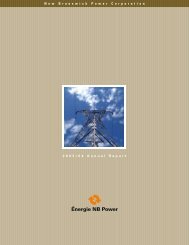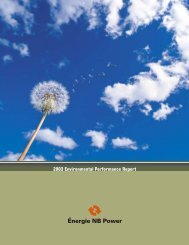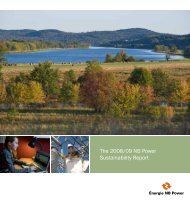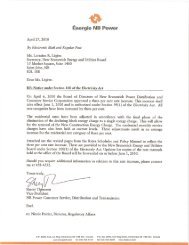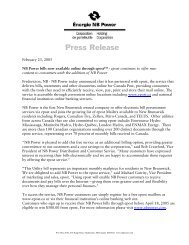Environmental Impact Assessment(EIA) Registration for the ...
Environmental Impact Assessment(EIA) Registration for the ...
Environmental Impact Assessment(EIA) Registration for the ...
Create successful ePaper yourself
Turn your PDF publications into a flip-book with our unique Google optimized e-Paper software.
REVISED PROJECT DESCRIPTION AND ENVIRONMENTAL IMPACT ASSESSMENT (<strong>EIA</strong>) REGISTRATION<br />
FOR THE NEPISIGUIT FALLS GENERATING STATION MODIFICATION AND REHABILITATION PROJECT<br />
Table 4.6<br />
Potential Interactions of Project-Related Accidents, Malfunctions, and<br />
Unplanned Events with <strong>the</strong> Environment<br />
Accident, Malfunction, or<br />
Unplanned Event<br />
Atmospheric Environment<br />
Water Resources<br />
Aquatic Environment<br />
Terrestrial Environment<br />
Wetland Environment<br />
Land Use and Economy<br />
Heritage Resources<br />
Current Use of Land and<br />
Resources <strong>for</strong> Traditional<br />
Purposes by Aboriginal Persons<br />
Key:<br />
0 No interaction. The environmental effects are rated not significant and are not considered fur<strong>the</strong>r in this report.<br />
1 Interaction will occur. However, based on past experience and professional judgment, <strong>the</strong> interaction would not result in a<br />
significant environmental effect, even without mitigation, or <strong>the</strong> interaction would clearly not be significant due to application of<br />
codified practices. The environmental effects are rated not significant and are not considered fur<strong>the</strong>r in this report.<br />
2 Interaction may, even with codified mitigation, result in a potentially significant environmental effect and/or is important to<br />
regulatory and/or public interest. Potential environmental effects are considered fur<strong>the</strong>r and in more detail in <strong>the</strong> EA.<br />
Road Transportation<br />
None of <strong>the</strong> identified Project-related Accidents, Malfunctions, or Unplanned Events will interact<br />
with <strong>the</strong> VECs ranked as 0 in Table 4.6, as no mechanisms <strong>for</strong> interaction have been identified.<br />
As no potential interaction with <strong>the</strong>se VECs has been identified, <strong>the</strong> environmental effects of<br />
<strong>the</strong>se Accidents, Malfunctions, and Unplanned events are rated not significant and will not be<br />
discussed fur<strong>the</strong>r.<br />
4.4.3.1 Loss of Containment<br />
Loss of Containment has <strong>the</strong> potential to interact with <strong>the</strong> Freshwater Environment, <strong>the</strong> Aquatic<br />
Environment, <strong>the</strong> Terrestrial Environment, Land use and Economy, Heritage Resources, and<br />
Current Use of Land and Resources <strong>for</strong> Traditional Purposes by Aboriginal Persons as indicated<br />
by <strong>the</strong>ir ranking of 1 in Table 4.6. There is potential <strong>for</strong> Loss of Containment during Construction<br />
activities; <strong>the</strong>re are no features of <strong>the</strong> future Operation of <strong>the</strong> Project that would increase <strong>the</strong> risk<br />
of Loss of Containment compared to <strong>the</strong> current operation of <strong>the</strong> NFGS. The potential<br />
environmental effects of Loss of Containment during future Decommissioning and<br />
Abandonment activities will be assessed in a future Decommissioning and Abandonment plan.<br />
Loss of Containment includes a partial or total failure of <strong>the</strong> NFGS or any of its components,<br />
resulting in temporary or permanent damage to structures and equipment as well as <strong>the</strong><br />
unplanned release of contained water in <strong>the</strong> reservoir downstream. Loss of Containment may<br />
occur from <strong>the</strong> failure of NFGS components due to damage or advanced age. Entrained debris<br />
could damage both <strong>the</strong> butterfly valve at <strong>the</strong> top of <strong>the</strong> system and <strong>the</strong> wicket gates at <strong>the</strong><br />
bottom of <strong>the</strong> system, which are necessary to control <strong>the</strong> flow through <strong>the</strong> generating station<br />
(Figure 2.1). In addition to substantial damage that this could cause to all components<br />
(e.g., turbine runner, scroll case, power shaft), damage to <strong>the</strong> valve and wicket gates could<br />
Page 66 June 15, 2011




